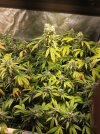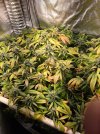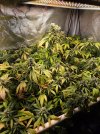I got my clones healthy again. I needed to 1) give them more calcium, 2) alkalize the potting mix, and 3) increase the PPMs of the nutrients. All three did the trick, the new growth is now a nice shade of green and leaves are larger.


In another
discussion I was reminded that my potting mix is recycled Kellogg's Palm Cactus & Citrus, which has no lime in the ingredients. It is not the similarly named G&B Organics Palm Cactus & Citrus which includes both dolomite and shell limes. Because of how I sanitize my potting mix with a soak in boiling water, the Kellogg product is a good choice, it has few ingredients, no manures or fertilizers added so little to nothing to be diluted and washed away during sanitation.
The calcium deficiency was solved with soluble gypsum dissolved in RO water as a saturated solution of 2.4 g/L, and is mixed at 18% of total irrigation volume. 1/4 teaspoon of powdered soluble gypsum (which equals 2 teaspoons/gallon) was topdressed to each Hefty™ cup as a one time application. To correct slightly low runoff or pour-through pH, 1/4 teaspoon powdered dolomitic lime was also topdressed. That's 1/2 teaspoon total, gypsum + lime, then watered in with nutrients as a one time application. Occasionally I'll monitor runoff pH and if and only if it drops below 6.4 to 6.3 then will give it more dolomite to raise pH and gypsum for slow-release calcium.
With regards to two of my vegetative nutrient formulas, 3-1-2 and 2-1-2 (relative NPKs), the first one has more calcium nitrate than the second one, other than that they're identical. I was using the 2-1-2 formula, it adds less than 100 PPM of electrical conductivity to the runoff, there's no significant salt build up in the potting mix over successive irrigations, no flushing is required. However, I perceived the plants could use more N so increased calcium nitrate. The 3-1-2 formula with roughly 2x more adds so much residual salt to the pot's runoff --- salt buildup which keeps increasing on each irrigation --- flushing is frequently required. I'm trying to find a good balance between maximizing calcium nitrate and optimizing salt build up, the solution seems to lie somewhere between those two formulas. My current gallon of nutes is 2.6-1-2 and pour-through increase is about 400 PPM. 2.5-1-2 is planned next.
The plants in the solo cup were irrigated with 125 mL nutes each, with about 40% runoff. Total volume for all three cups was 375 mL with about 150 mL runoff. Saturated gypsum of 550 PPMs of Ca is used at a rate of 18% for 99 PPMs added Ca. With 1/4 teaspoon dolomitic lime added to each Hefty™ cup, and nutrients mixed to about 6.5 pH, runoff is about 6.6 to 6.7 pH, a small overshoot.
To make the nutrients: 375 mL x 18% = 67 ml of saturated dissolved gypsum solution is added to irrigation container, then add nutes to it for the full 375 mL total. Storing them separately and combining at irrigation time is an attempt to eliminate pH-decrease acidification during storage, hopefully making the premixed nutrients more pH stable.
Weighing by grams is my newest water-measurement technique, 1 mL water is about 1 g. It seems intuitive that as calcium nitrate is added --- which leaves more salts behind --- less saturated gypsum may be needed.
The clones were cut in late November and mid December 2022. They are 177 and 152 days old, 5 to 6 months. They were growing so nicely today I decided the nutrients were good enough and up-potted. I was careful to make sure each pot weighed about the same, they're all around 2100 g without the drain tray.
I didn't put quite as much dolomite in the new potting mix, 1/3 teaspoon each pot of dolomite and gypsum, and a little more earthworm castings followed by a good mixing. Each bleach-sanitized pot is measured at 2.2 L. The potting mix was 1/2 recycled mix from last grow, re-screened and re-sanitized (which resulted in diminished volume due to breakdown of particle size). I'm not certain I'll ever recycle potting mix again, but I'm certain my nutrients are improved. If pour-through pH is too low going forward. I'll add a little more dolomite and gypsum as topdressing. The rate I used is less than 1 teaspoon per gallon, just a little bit. I'd like to get the same pH running out as pouring in, and 1/4 teaspoon in each plastic cup alkalized a little bit too much.

 Here's a good PDF by Richard Evans at UC Davis Department of Plant Sciences.
Here's a good PDF by Richard Evans at UC Davis Department of Plant Sciences. He has a nice description of how potting mix particle size relates to saturation levels during irrigation (which explains why I screen even my new potting mix) and how water flows differently in soil versus pots. When growing in soil under the sun, supplemental N and maybe P are all that's needed.






















































